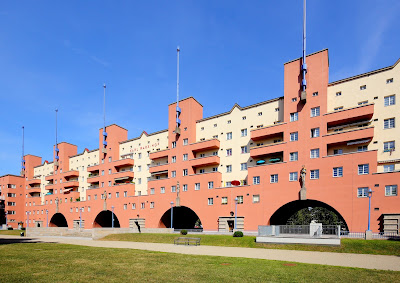On this weekend, the weekend of February 12th, we honour those who, eighty-two years ago, were the first to bravely and openly resist a fascist government in Europe militarily - the workers of Austria. February 12th to 15th 1934 marked the end of the First Republic and of "Red Vienna" and the establishment of open fascism in Austria.
In Austria, the First Republic, which had been founded after the end of the Habsburg Monarchy in 1919, was increasingly dismantled by the ruling Christian Social Party (which was backed by the Italian fascists), from early 1933. On March 4th of that year, Austrian Chancellor Engelbert Dollfuß of the CSP dissolved the parliament, officially due to "insurmountable differences" between the parliamentary parties in debates over how to react to a strike of the train workers. An attempt to convene again on March 15 was then forcefully shut down by the police. From then on, Dollfuß governed de facto dictatorially and without checks, by constitutional "emergency laws". Fascist paramilitary forces, most prominently the "Heimwehr", Home Guard, increasingly took to the streets to fight against the striking workers and the defenders of the Republic, whose defence forces, the forces of the Socialist Worker's Party of Austria, were the "Republikanischer Schutzbund", Republican Protection League. Although they were not officially the state executive, the actions of the fascist Heimwehr were approved and backed by the Dollfuß government, which used them to crush any strikes and other republican, i.e. Socialist or Social Democratic resistance. During 1933, major Socialist figures and leaders were arrested and the state of the working class in Austria became disastrous in early 1934.
 |
| Fighting also took place at the Schlingerhof in Vienna (Floridsdorf district), where a large cache of weapons was based. Source: user:Extrawurst, Wikimedia Commons |
On February 11th of that year, the Interior Ministry announced that a nationwide raid, officially to search for weapons hidden in the homes of Socialist leaders and workers, would take place the next day. Upon hearing that, the Schutzbund commander of Linz, Upper Austria, Richard Bernaschek, decided to take up arms against the police and Heimwehr forces. This was the outbreak of fierce fighting. Artillery, and in one case even the air force, was used to crush the workers, who rose up in their homes, the famous large blocks called "Gemeindebauten", public workers' housing complexes (pictured are the famous Karl-Marx-Hof and the Schlingerhof) on the outskirts of Vienna (which had been built by the Socialist city councils of Vienna between 1918 and the early 1930s ("Red Vienna")), and in some smaller towns, most of them in the industrialized regions of Upper Austria and Styria.
After three days of fighting, with several hundred of them (and about a hundred state and Heimwehr forces) dead, the workers gave up. Several hundred "civilians" also died as a result of the fighting in the and the artillery fired into the workers' housing blocks. As a punishment for their resistance, the Socialist Party, who had been weakened already before the fighting, was now officially banned. The republican constitution was replaced by a constitution modelled on Mussolini's fascism in Italy. The Austrian fascism was linked more closely to Italy (and to the Catholic Church (clerical fascism)) than to Hitler's Nazi Germany, and could resist being taken over by the latter for four years, but it nevertheless was fascism, too.
Thus, contrary to what many still claim and what was still taught in history curricula for decades after WWII, fascism in Austria didn't just start with the annexation ("Anschluss") by Nazi Germany in 1938, but already four years earlier, when democracy and the Austrian form of socialism (with the most prominent example being the capital, "Red Vienna") was crushed, from February 12th to 15th.


Keine Kommentare:
Kommentar veröffentlichen